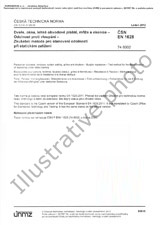We need your consent to use the individual data so that you can see information about your interests, among other things. Click "OK" to give your consent.
ČSN EN 12572-3 (942050)
Artificial climbing structures - Part 3: Safety requirements and test methods for climbing holds
Translate name
STANDARD published on 1.9.2017
The information about the standard:
Designation standards: ČSN EN 12572-3
Classification mark: 942050
Catalog number: 502418
Publication date standards: 1.9.2017
SKU: NS-693059
The number of pages: 16
Approximate weight : 48 g (0.11 lbs)
Country: Czech technical standard
Category: Technical standards ČSN
The category - similar standards:
Annotation of standard text ČSN EN 12572-3 (942050):
This European Standard specifies the safety requirements and test methods for climbing holds.
This European Standard is applicable to climbing holds, which are used for the natural progression of the climber, i.e. without the use of artificial means (e.g. ice axes, crampons, hooks, nuts) on artificial climbing structures (ACS) and bouldering walls. Climbing holds are designed to be mounted on the ACS with bolts, screws, etc. Climbing holds include large volumes or features that are designed for use without additional climbing holds being attached to them. The main fixation points for climbing holds forms part of the existing layout of the ACS and are considered in EN 12572 1 and EN 12572 2.
This European Standard is not applicable to ice climbing, dry tooling and playground equipment
Preview of the standard ČSN EN 12572-3 (942050)
We recommend:
Technical standards updating
Do you want to make sure you use only the valid technical standards?
We can offer you a solution which will provide you a monthly overview concerning the updating of standards which you use.
Would you like to know more? Look at this page.




 Cookies
Cookies
